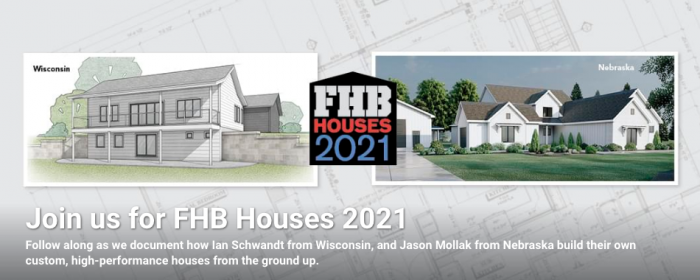Podcast 356: Living with Your Own Work, Lowering a Basement Floor, and Hinge-Prepping Doors
Brian, Matt, and Patrick hear from listeners about good-looking gate hinges and real-world budgets before taking listener questions about living with your own work, lowering a basement floor, and the best way to fit and prep doors.
Follow the Fine Homebuilding Podcast on your favorite app. Subscribe now and don’t miss an episode:
 |
 |
Help us make better episodes and enter for a chance to win an FHB Podcast T-shirt:
www.finehomebuilding.com/podcastsurvey
Mike shares some good-looking adjustable gate hinges. Andrew asks about building a good house on a realistic budget. Another Andrew describes disposable respirators and where to get them. Tom wants to know how to live with his imperfect home improvements. Neil asks about his engineer’s plan to lower his basement floor. Rick wants to put radiant heat under his bowling alley floors. Wayne asks for help prepping new interior doors for existing openings.
Editor Updates:
- Brian’s real estate woes
- Matt’s new lawn mower
- Jeff’s mulching
- Patrick’s patio
Listener Feedback 1:
Mike in Seattle writes: Greetings FHB, I think it was Patrick who on an episode in the last month or so was seeking decent gate hardware, specifically hinges. A few years back I came across this adjustable strap hinge from Locinox. I used the Locinox hinge system and their Locinox mortised latch on a gate project I built for a client and it was a true joy to install due to its adjustability and the clean aesthetic. Keep up the fine podcast.
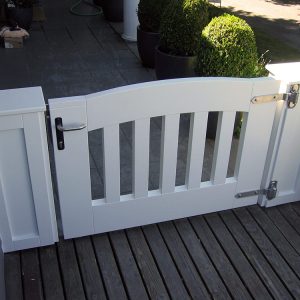 |
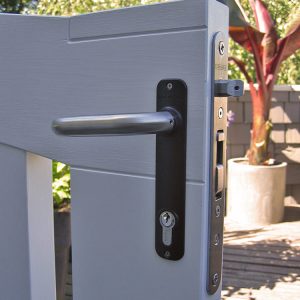 |
 |
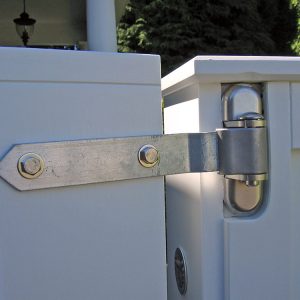 |
 |
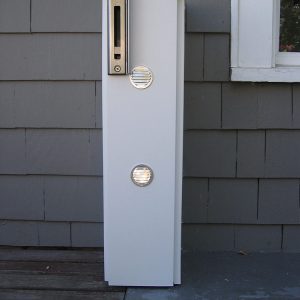 |
Related Link:
Listener Feedback 2:
Andrew in Durham, NC writes: My name is Andrew Hove. I’m a fairly young builder in Durham, NC and just wanted to write in to say thank you. Your content in the magazine, and on the podcast, is superb. I really enjoy the practical help and information in an industry where quality help is often hard to find. I’ve been lucky to have a business partner who has taken me under his wing, but I only started building professionally 3 years ago- the learning curve was rough and steep. You guys have helped me a ton and I am very grateful for this.
I’ve listened to everything I can get my hands on from building science geeks and the passive house crowd, but I think there is a pretty big disconnect between that world and the reality that a lot of builders live in. It’s awesome to see Steve B, or Matt Risinger pontificate on $50,000 HVAC systems, and R40 wall assemblies, but what about a builder who is just trying to build a solid 300k spec house, or a tradesman who works on affordable rental units? The real estate market here allows me to play in both the high-end world and the affordable space, but there seems to be a huge need in this country for solid houses between 250 and 400k. I’d love to hear or see a multiple part series from a builder who makes decisions and executes a build in this price point. The reality is that you have to make some unsexy decisions when you’re trying to hit a real-world budget – but seeing and documenting that process and spending money in wise ways would be invaluable for the community and home Building as an industry. Thanks again for everything even if you hate my idea haha.
Related Links:
- Building the Best Affordable House: 10 Tips for Getting the Most House for Your Money
- Building Better Affordable Homes
Listener Feedback 3:
Andrew writes: Hi, I heard this on the podcast and figured I’d share some information that may be useful. N95s are widely available at the usual online industrial suppliers (zoro, digikey, mcmaster, majidglove, grainger, mscdirect, airgas, etc). There are also N95-equivalents (KF94, FFP2, KN95) available from behealthyusa.net, kollecteusa.com, masklab.us (and masklab.hk), and also bonafidemasks.com — all of these sources have been verified with the manufacturers as direct buyers/authorized resellers. Ask for mask buckles if you order.
Make sure they seal properly, get a variety to find the one that fits you best. You can reuse it if you let it sit in a breathable space (e.g. not inside a plastic bag) for 4 days between uses. You can reuse until it does not seal, or 40 hours of wear time, whichever comes first. Mark the date of last use on the storage container e.g. paper bag.
Exhalation valves don’t really matter unless the place you are going has a rule against them. The CDC found that even with a valve, a respirator will still perform source control of particles as well as a cloth or surgical mask.
Early on in the pandemic I was looking around for options because my sibling has cancer, and also a developmental disability, so the combination of increased risk and difficulty in making sure that she is taking precautions motivated us to find something better than a cloth mask. We also had some experience looking for disposable respirators due to a few wildfire seasons. Finally, relatives overseas had a lot of info about seasonal mask wearing in general (much more common in Taiwan, Korea). We wanted to find options for people that wouldn’t take away from the supply for healthcare workers, and it turned out that by June, Korea had lifted its export restriction on KF94 respirators. Although I didn’t work directly with Aaron Collins, he basically made it possible for people to have some confidence in the KF94 standard, which turned out to be pretty robust and in some ways more rigorous than the N95 standard. So basically I was just spamming the same info you received to my friends and family, based on his work. Now if only I can convince the same people to purchase energy efficient homes… Anyways keep up the great work on the podcast and everything else! For more detailed information, check out Aaron Collins on youtube.
Question 1: How can I avoid perfectionism when working on the home that I live in?
Tom writes: Hey FHB Podcast. After having done a significant amount of work on the last two houses I’ve owned, I’ve discovered a serious problem. I’m wondering if any of you have solved this yet. If you do work on your house in any part that gets normal traffic how do you walk past your work and not stare at the imperfections?
Maybe I’m further on the perfectionist end of things, but I can’t help but glare at the corner of the tile that doesn’t quite sit flush or the slightest bump in spackle whenever I walk by my own work. I love working on my own house, but how do you live in it without achieving perfection?!
Question 2: Is my thick “alley” flooring compatible with floor heating?
Rick in Ontario Canada writes: Rick here in Ontario Canada. From another project I have ended up with the ‘alley’ flooring from a bowling alley; ~ 2.5 inch thick hardwood, about one-inch strips glued together… finished on top, underside with some sort of a pitch coat.
What I’m wondering about, possibly for an addition to my house, could that be used with floor heating? I will have whatever access is needed to the underside, which will be above a full basement. I suppose the question is, assuming the heat doesn’t degrade the glues or cause some sort of warping, do you see any problem from the thickness? We heat large slabs of concrete… would this be any different? It of course is very old wood given decades to cure, as much as it would… Otherwise I may just end up going into the butcher-block business. Cheers, Rick, in the rapidly thawing Great White North
Related Links:
Question 3: How far down should I excavate to level the floor of my basement?
Neil from Sault Ste. Marie, ON writes: Dear FHB crew, When the basement in my 1950’s cape began to leak I busted out the perimeter of the concrete floor to drill a 1/2” hole in the bottom concrete block cells, install DELTA-MS dimple board and interior weeping tile. 4 days later water problem solved.
However, I never got around to patching the perimeter of the concrete floor because during the repair I noticed that my foundation footer/walls were 3-4” out of level and the floor was poured in the shape of a bowl and 8” out of level. When the first floor was framed they did a lot of interesting shimming/notching to get it relatively level! I also discovered that I didn’t have enough headroom to legally finish my basement as city hall wouldn’t allow grandfathering. Project put on hold.
7 years later I want to finish this space and turn it into a hair salon so my wife can work from home. The payback is less than 3 years. I found an engineer willing to design a benching system to lower the finished floor height approx. 8” to match the floor height in my ‘90s addition. I had some concerns with the engineer’s initial design (1st pic) regarding the excavation detail (straight down then 45 degrees), water management (didn’t account for weep holes in the concrete block) and insulation (airspace and vapour barrier).
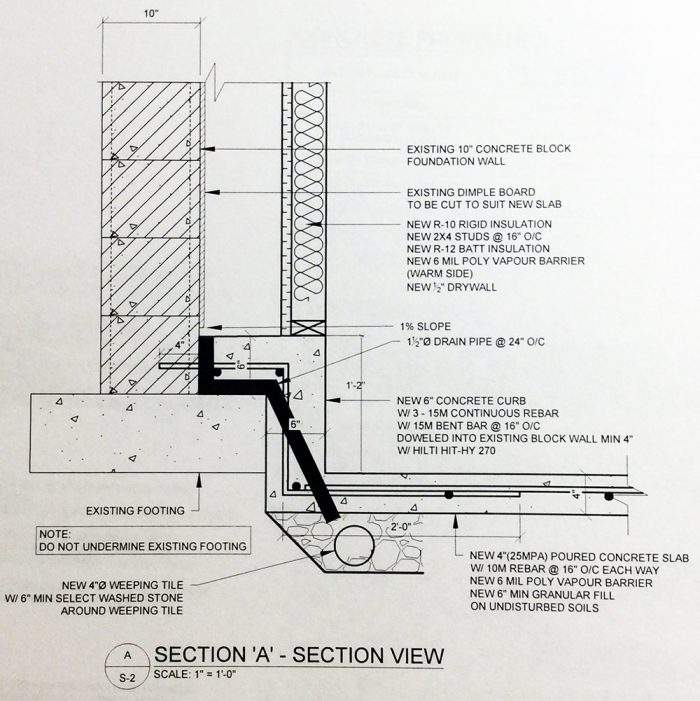 |
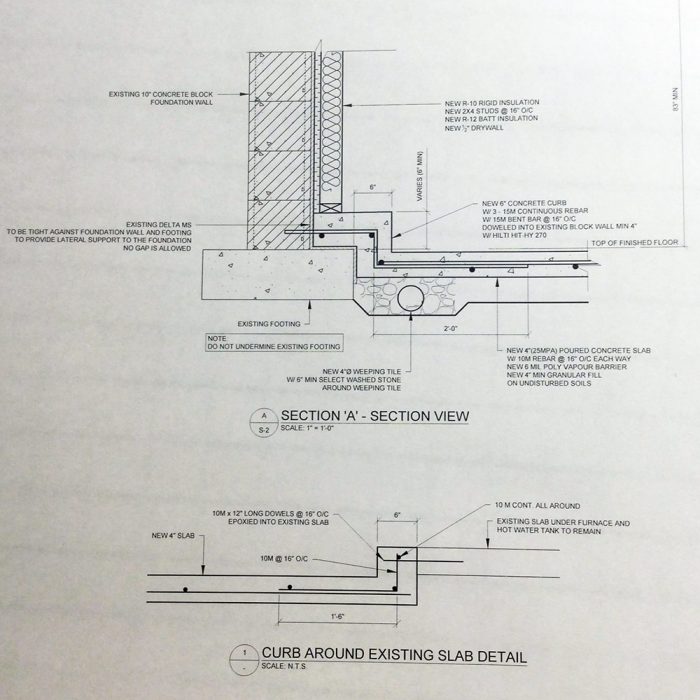 |
I also had my own concerns regarding water management as I dug a test hole this spring to required depth and over a few days it accumulated a couple of inches of water. This won’t be helped by the time-frame because, realistically, working alone, this might take me into the wet fall and cold winter. And is digging so deep playing with fire in a 70yr old house?
After a week of sleepless nights, I pushed back on the above to the engineer and also decided to just lower the finished floor height 4” not 8”. I basically excavated to this depth 7yrs ago for weeping tile and haven’t had any issues – even without the concrete floor to hold back walls from soil pressure! Revised drawing attached (2nd and 3rd pics).
Now I am second guessing myself. Am I wasting a golden opportunity only going down 4”? Should I excavate below the depth of my footer 0-2” or 2-6” (measurements vary because footer is out of level)? 0-2” below the footer will give me legal headroom (6’11” main and 6’5” under beams/ducts) but a 4” step/tripping hazard between old and new foundation. How much riskier is the extra 4” for a fairly accomplished but slow DIY’er? Foundation is 10” block wall on a 26”x7” footer on hardpan clay 5ft below grade.
Appreciate the show and the sober second thought.
Thanks, Nervous Neil
Sault Ste. Marie, ON (3hrs north of Patrick’s favourite place to visit). Climate zone 7. Canadian Bushplane Heritage Centre
Related Link:
Question 4: How do I prep a door to install hinges?
Wayne writes: Good afternoon Patrick, Thanks for discussing my proposed project during Podcast 248. I found my original invoice for the shaker 2-panel doors I used in the addition. Cost ranged between $100 and $122 per blank. I decided to buy new versus refurbish the existing flush doors. I do not have the luxury of a large garage workshop to tie up the space for 10 door modifications. I would never be able to do 10 doors in one day as stated in the YouTube video.
I think my time would be better spent learning and honing my skills fitting and hanging new doors as was suggested by yourself and guests. I have not prepped doors for hinges before but have the appropriate routers. Any tips on jigs for hinge prep? Make my own or buy? I enjoy your contractor guests. I share their passion for good design, attention to detail and execution. I have spent much of my 54 years in the architectural profession as a building science specialist, problem solving and detailing. I love to solve a complex detail. Never stop learning. Wish you all the best. Take care, be safe, stay healthy
Related Links:
- How to Transfer Hinge Locations to a Replacement Door
- How to Mortise Hinges With a Chisel
- Windows & Doors Project Guide: Door Basics
End Notes:
Check out our new 2021 FHB Houses:
Visit the Taunton Store • Magazine Index • Online Archive • Our First Issues • All Access
Help us make better episodes and enter for a chance to win an FHB Podcast T-shirt: www.finehomebuilding.com/podcastsurvey

If you have any questions you would like us to dig into for a future show, shoot an email our way: [email protected].
If we use your question we’ll send you a FHB Podcast sticker!
FHB Podcast T-shirts!
Represent your favorite podcast! Available in several styles and colors. Made from 100% cotton. Find the Podcast t-shirt and more cool products in the Fine Homebuilding Store.
This episode of the Fine Homebuilding podcast is brought to you by BUILDBOOK.
A lot of construction pros have a common problem; your construction management software is either non-existent, or it is too slow and too complex. It shouldn’t be bogged down with complicated features that you have to attend an academy to learn how to use. You need software you can start using DAY ONE without training… That is faster and more reliable than your notepad. That allows you, your team and your clients to always know what’s getting done and when. And your software should reduce stress, not increase it. The solution? BuildBook.
BuildBook is built for today’s modern builder with everything you need, nothing you don’t. Whether you’re a one man operation or a business with a large crew, BuildBook has plans to fit your budget. No nagging sales calls, tricky upsells or hidden fees. Head over to BuildBook.co and sign up for a free 10-day trial — and don’t forget to mention that you heard about them on the Fine Homebuilding podcast.
Fine Homebuilding podcast listeners can now get 20% off anything in the Taunton store, including Insulate & Weatherize.
Use the discount code FHBPODCAST to take advantage of this special offer.
We hope you will take advantage of a great offer for our podcast listeners: A special 20% off the discounted rate to subscribe to the Fine Homebuilding print magazine. That link goes to finehomebuilding.com/podoffer.
The show is driven by our listeners, so please subscribe and rate us on iTunes or Google Play, and if you have any questions you would like us to dig into for a future show, shoot an email our way: [email protected]. Also, be sure to follow Fine Homebuilding on Instagram, and “like” us on Facebook. Note that you can watch the show above, or on YouTube at the Fine Homebuilding YouTube Channel.
The Fine Homebuilding Podcast embodies Fine Homebuilding magazine’s commitment to the preservation of craftsmanship and the advancement of home performance in residential construction. The show is an informal but vigorous conversation about the techniques and principles that allow listeners to master their design and building challenges.
Other related links
-
- All FHB podcast show notes: FineHomebuilding.com/podcast.
- #KeepCraftAlive T-shirts and hats support scholarships for building trades students. So order some gear at KeepCraftAlive.org.
- The direct link to the online store is here.
